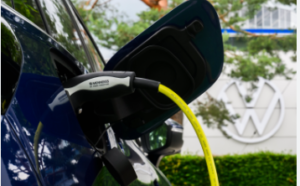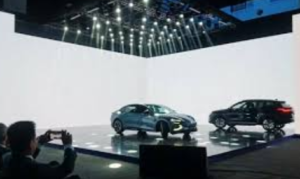As electric vehicle (EV) demand falters across Europe, major automakers are grappling with an alarming reality: the prospect of substantial fines due to tightening carbon regulations is becoming increasingly likely. With the clock ticking toward stricter emission targets, the pressure is mounting on car manufacturers to rethink their strategies amidst a rapidly evolving market landscape.
The Tightening Regulatory Landscape
Starting next year, European car manufacturers will face a dramatic shift in regulatory requirements. The EU’s cap on average emissions from new vehicle sales is set to plunge to just 93.6 grams of CO2 per kilometer. This marks a significant 15% decrease from the 2021 baseline of 110.1 g/km, and the implications are profound. Exceeding these limits could lead to crippling financial penalties that threaten the profitability and sustainability of established automotive giants.
Renault’s CEO, Luca de Meo, recently emphasized the severity of the situation, warning that if current EV sales levels persist, the European auto industry could face fines totaling 15 billion euros (approximately $16.5 billion) or be compelled to cease production of over 2.5 million vehicles. Such staggering figures underscore the urgent need for effective action to boost EV sales and comply with upcoming regulations.
The Financial Stakes of Non-Compliance
According to Rico Luman, a senior sector economist for transport and logistics at ING, the potential financial penalties are colossal. “The fines are massive; when calculated based on production volumes, they could easily run into millions for each manufacturer,” Luman stated.

The European Automobile Manufacturers’ Association (ACEA) has echoed these concerns, highlighting that the industry is currently lacking “crucial conditions” to facilitate a smooth transition to zero-emission vehicles. Representing key players such as BMW, Ferrari, Volkswagen, and Volvo, ACEA is calling for urgent relief measures from EU institutions before the new CO2 targets come into effect in 2025.
Challenges in the Transition to Electrification
Europe’s automakers are facing a perfect storm of challenges as they strive for full electrification. These challenges include a lack of affordable electric models, a slower-than-anticipated rollout of charging infrastructure, and the potential impact of European tariffs on EVs manufactured in China.
Despite the push for electrification, many manufacturers remain focused on conventional hybrids and internal combustion engine (ICE) vehicles due to their higher profitability. Luman noted, “Manufacturers are primarily concentrated on hybrids and ICE vehicles because they yield higher profit margins.” This reliance on traditional models complicates the transition to electric vehicles and raises questions about the long-term sustainability of current strategies.
Declining EV Market Share
Recent statistics underscore the urgency of the situation. The EU’s market share for battery electric vehicles has declined to 12.6% this year, down from 13.9% in 2023. Furthermore, overall car sales in the EU remain approximately 18% lower than pre-pandemic levels observed in 2019.
Xavier Demeulenaere, associate director of sustainable mobility at S&P Global Mobility, pointed out that all original equipment manufacturers (OEMs) have a “strong incentive” to increase their EV sales in order to lower average fleet emissions and meet regulatory targets. However, the current economic downturn and the removal or reduction of subsidies in some countries have exacerbated the demand issues faced by these manufacturers.
Mitigating Financial Penalties
In light of the looming financial penalties, some automakers are exploring pooling—a collaborative approach that allows manufacturers to be assessed as a single entity regarding their CO2 emissions. This strategy could serve as a crucial buffer against potential fines, allowing companies to collectively meet compliance targets.
However, the effectiveness of pooling depends on the cooperation and performance of all participating manufacturers, which may be challenging in an increasingly competitive market. The need for manufacturers to align their interests could pose difficulties as they strive to maintain their market positions.
Is This a Crisis?
While the challenges facing Europe’s automotive sector are significant, not everyone views the current situation as a full-blown crisis. The campaign group Transport & Environment characterizes these challenges as a transitional phase, suggesting that manufacturers have had ample time to adapt to new regulations since the EU established its targets in 2019.
Analysts within the group argue that automakers can mitigate large fines by increasing sales of hybrids and fuel-efficient vehicles. Additionally, manufacturers can benefit from regulatory flexibilities that help to lower their reported emissions artificially. “Carmakers may need to sell fewer large SUVs, but that’s precisely the goal of CO2 regulations,” they noted.

The Road Ahead: A Balancing Act
As the automotive industry navigates this critical juncture, the balance between profitability and regulatory compliance will be paramount. Automakers must innovate and adapt while keeping a close eye on their financial health. The looming threat of substantial fines necessitates urgent action to accelerate the transition to electric vehicles.
Conclusion: The Call for Collaboration
In conclusion, the anxiety felt by Europe’s top automakers regarding potential fines and the faltering demand for electric vehicles marks a pivotal moment in the industry. As they prepare for stricter regulations and navigate an increasingly competitive landscape, collaboration and innovation will be essential for success.
The path toward a sustainable automotive future may be fraught with challenges, but it also presents opportunities for those willing to embrace change. As the deadline for compliance approaches, the automotive sector must come together to address the regulatory pressures while ensuring that they meet consumer demands for affordable, efficient, and environmentally-friendly vehicles.
As we move toward 2025, all eyes will be on Europe’s automotive giants as they seek to balance immediate financial pressures with the long-term vision of a greener, more sustainable transportation landscape. The ability to adapt and respond to these evolving challenges will determine the future of the industry in an era defined by innovation and responsibility.

